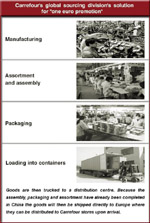|
Page
3 of 4
Another issue was the fact they were
dealing with several categories of products,
including toys, hand tools and kitchen utensils.
Depending on the size and shape of the merchandise,
one display could hold anything between
100 and 800 pieces.
With all the necessary arrange-ments
in place, they faced packing 27 million
pieces in four to five weeks. They positioned
between 600 and 700 staff at the 8,000-square-metre
warehouse in Shanghai, a platform set up
entirely for packing. Given the limited
amount of space for the goods, they devised
a continuous supply flow, preparing a very
tight schedule with the vendors.
A team of about 20 people were dedicated
to managing the inventory with the vendors,
receiving the goods at the warehouse, arranging
for Customs clearance, with the import-export
company in the middle, and making all the
financial arrangements. They ensure the
vendors received their tax refund after
the goods had been exported and paid for.
Producing one export document for containers
holding up to 100 to 120 displays, with
goods from 20 to 25 different factories
proved a mammoth task.
To give you an idea of the numbers involved,
for the June promotion, they were dealing
with around 450 containers loaded with a
total of 27 million pieces of merchandise
destined for shipment overseas.
"This export document cannot be
cut into 25 pieces. So the import-export
company was receiving the tax refund from
the Tax Bureau in China, and passed back
the tax to the factories.
You need also a lot of support from the
factories, if you want to do this but if
you don't have the name, basically you can't
do it, because they say 'who is going to
pay me, how am I going to receive my tax
refund?' We needed also to give some guarantees
to the vendors that everything is going
to be fine. That we would honour the payments
and prepare the relevant documentation in
order for them to be able to claim the tax
back," Mr Martin said.
Two months after the successful June
promotion at Carrefour stores worldwide,
they were asked to repeat the operation.
This time for 22 million pieces in September,
giving them one month to make the arrangements.
How do you handle deliveries within a
four-week time frame? They realised this
required a second warehouse to receive the
stock. The warehouse was located 30 kilometres
away, and every night a fleet of 30 trucks
would deliver goods from the stock warehouse
to the assembly platform to feed the assembly
line for the next day.
Labelling the products in the right language
could not be done by the factories. They
established a team of 10 to prepare the
import labels for 13 to 15 different languages.
They grouped the languages of neighbouring
countries together so that one label could
contain a number of different languages.
The third operation came in December
2003 with 45 million pieces, yet none of
the operations needed upfront investment.
To finance the projects each retail country
was offered a price for the goods.
The price included the costs from the
factory, labour, display units, warehousing
to shipment. It was necessary to buy the
goods at between 10 and 60 cents apiece
or they would suffer a loss. Ten cents was
added to each item to cover the costs, an
adequate amount given the large quantity
of goods.
 click image
to enlarge click image
to enlarge
In the June promotion alone, Carrefour
earned about EUR30 million (US$40.79 million)
in sales across 30 stores worldwide, and
EUR100 million for all three.
Two years later and the Carrefour concept
had collapsed. Although the French retailer
continues to source from China, it has since
abandoned this method of supply chain management.
And according to Mr Martin, it has been
to their detriment.
Page 1 2
3 4
[Next]
|